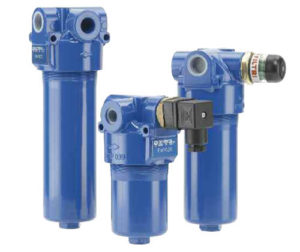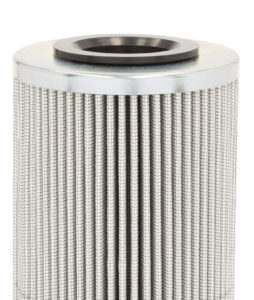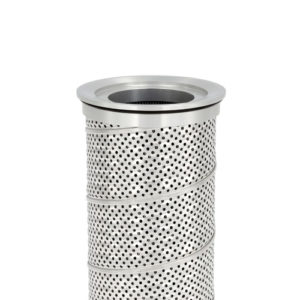
The upcoming IFPE show, in Las Vegas from March 7-11, will allow fluid power designers to see the latest in hydraulic filter technologies. Read on to see how these critical components are used in mobile machinery, as well as a listing of what IFPE booths you can visit for more information on hydraulic filters.
A reliable and efficient hydraulic system starts with the fluid. Keeping hydraulic oil conditioned and free of contaminants, air, water and heat is critical to ensuring that all system components run as they are meant to. To ensure this dependability, proper fluid filtration is required and should be taken with great care.
Contamination often enters a machine during startup, when particles from machine operations, be they metal shavings or sawdust or plastic bits, enter hoses, actuators, reservoirs and the ports in manifolds. These particles can also flood a system during maintenance, if proper preventions aren’t taken, or during a complete machine failure.
To prevent these particles from entering a system, you can use one of three main types of filters. The first, the suction filter, is mounted in the reservoir and attached to the suction line to protect downstream components, such as the pump. They are meant to catch coarse, large particles, so are not effective in trapping the major culprits of wear—fine particles. These mesh steel filters are often not included in a system’s filtration design, as they can cause clogging and pump cavitation.

Next up is the pressure filter, which is installed right in the pressure line, downstream of pumps and other system circuits when a system requires fine filtration. This traps particles in fluid as it flows from the pump, so protects all components downstream of the pump. You must select a pressure filter that matches the system pressure you’ll be operating in, but they are generally available in wide ranges up to and higher than 10,000 psi.
The most common type of filter is the return line filter, which traps very fine particles before the fluid reenters the reservoir. Spin-on filter and in-tank drop-in assemblies are the most popular. Spin-on filters are used heavily on mobile equipment. They are rated for most fluid types and a range of pressures and temperatures. They are available in glass, cellulose fibers and paper filter media. Water-absorbing medias may also be included, to remove freestanding water from oil.
Growing in use in the mobile market are in-tank return filters. They use stronger filter media, such as synthetic and natural fibers and stainless steel wire mesh. Constructed usually of steel, aluminum or plastic, they are better able to handle heavy-duty applications. And because they are located in the filter stream, they can remove most of the fine particles that are present throughout the rest of the system, ensuring clean fluid enters the reservoir.

When selecting a filter you need to know what size particles it is rated to remove from the oil in one pass through the filter media element. You must also know its efficiency or Beta ratio or the ratio of particles upstream of the filter to downstream of the filter during standardized testing. For example, we know how efficient a filter was at removing 10-micron particles in a single pass, such as 99%. In this case, “10 micron at Beta 200,” means the filter is 99.5% efficient at removing 10-micron particles in one pass. The lower the micron rating and higher the efficiency rating the better.
Other considerations include pressure drop, flow rating and sizing, and obviously, price. A note about flow rate: if sized improperly, it could break, releasing all the collected contaminants back into the system.
Finally, filters are often equipped with an indicator of when they are reaching their capacity. Pay close attention to these signals as they help with maintenance scheduling and reduce downtime.
Hydraulic filter manufacturers & suppliers at IFPE
| Exhibitor | Booth # |
| Apureda Filtration | B93602 |
| ARGO-HYTOS Inc | S83356 |
| Baldwin Filters | S85116 |
| Canimex | S83120 |
| Casappa Corporation | S81230 |
| Cim-Tek Filtration | B90103 |
| Donaldson Company, Inc. | S83940 |
| Elettrotec Srl | S80043 |
| FFP Products | S80155 |
| FluiDyne Fluid Power | S80634 |
| HANSA-FLEX USA | B9307 |
| Honor Gear Pumps Corp | S81942 |
| HYDAC Technology Corp./Schroeder Industries | S81140 |
| Hy-Pro Filtration | S80750 |
| International FPA | S83630 |
| Leemin Hydraulic Co., Ltd | S83239 |
| Maradyne Corporation | S83209 |
| Mid-West Instrument | S83144 |
| MP Filtri USA Inc | S80547 |
| Ningbo Jiangbei District Cicheng Pneumatic Components Factory | S82154 |
| Scientific Dust Collectors | S62349 |
| Separ Filter / Separ of the Americas, LLC | B93608 |
| Shaw Development, LLC | B93320 |
| Stauff Corporation | S81805 |
| Sun Hydraulics Corporation | S81029 |
| SunSource | S81039 |
| Swanson Industries | G71207 |
| TON WEIGHT MACHINERY MFG. CO., LTD. | S82110 |
| Veljan Hydrair Limited | S82618 |
| Zinga Industries | S81330 |

Leave a Reply